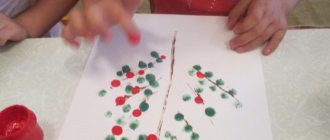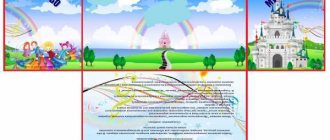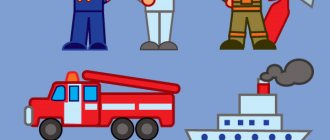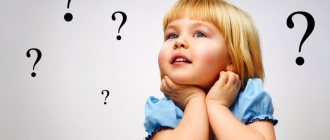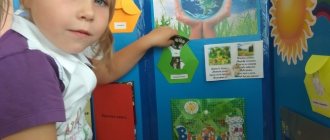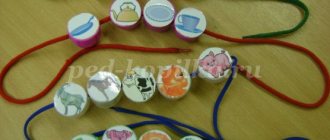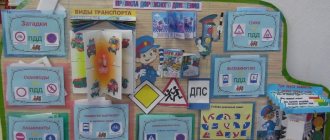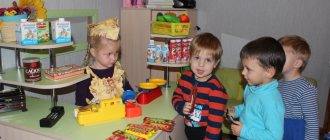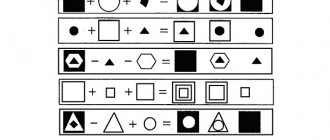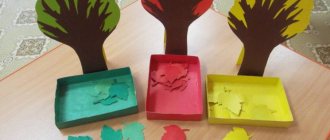Teaching numeracy, systematized and methodologically justified by the Federal State Educational Standard (FSES), is included in the system of work with preschoolers in kindergarten. However, the age characteristics of children require particularly careful preparation of visual aids. The most important role is given to the counting material. We will look at the types of counting material used in mathematics classes in different age groups, and give advice on how to make it yourself as a demonstration and handout.
- 2 Features of demonstration and handout material for different age groups
2.1 Types of handouts2.1.1 Photo gallery: examples of counting handouts
- 3.1 How to make didactic materials for the preparatory group with your own hands
3.1.1 Photo gallery: example of a homemade laptop
- 4.1 Photo gallery: examples of individual cards and a picture for a mobile folder
- 5.1 Photo gallery: individual cards for the senior group
The validity of using visual counting material in kindergarten
In a preschool educational institution, children begin to master counting at the age of three, and this is their main mathematical activity. Learning takes place with the indispensable support of visual aids, since abstract logical operations performed during counting (merging and dividing sets, comparing quantities and numbers, comparing sets) are difficult for children to understand and require “objectification.” Visual counting material is a comprehensive didactic tool aimed at developing basic ideas about counting as part of targeted learning.
Famous teacher K.D. Ushinsky said: “Children’s nature itself requires visual learning.”
Such benefits are very diverse, and their application in each case depends on:
- specific content of educational material (for example, teach children of the second youngest group to distinguish between the concepts of many and few);
- methods used (more precisely, certain gaming techniques, for example, illustrations for a fairy tale in which characters learn to count);
- the age of the children (if in the second younger group there may be cards with pictures of the same animal, then in the older group the pictures depict different animals, that is, the essence of the phenomenon being described becomes more complex).
Counting in kindergarten is mastered along with other didactic skills and concepts, for example, learning about colors: distribute the mushrooms into baskets of the corresponding colors and say which one has more/fewer of them
Visual material must meet the following requirements:
- scientific (correspond to scientific data on counting);
- pedagogical (carry an educational, developmental, educational load);
- sanitary and hygienic (do not contain harmful substances, do not cause eye strain;
- aesthetic (beautiful design, bright and clear images)
What are the properties and tasks of counting material
The main task of counting material is to visualize the counting process and make learning new knowledge easier. Another challenge is keeping children's fragile attention. This is due to the properties of the demonstration material - bright, rich colors and content that is interesting for a preschooler (counting items - toys or fairy tale characters).
Material for teaching numeracy should:
- meet sanitary and hygienic standards (made from harmless substances, be large enough);
- be filled with educational and educational content;
- be aesthetic.
The properties of counting material are dictated by the age of the students. Thus, for younger schoolchildren with already developing abstract thinking, discreet sticks are suitable so as not to distract children from the essence of the task with the game content.
Note! Children in kindergarten, on the contrary, need bright play sets and the use of game plots in order to understand the mechanisms of counting.
Teaching numeracy in kindergarten, as well as acquiring other cognitive skills, must comply with federal standards - Federal State Educational Standard for Preschool Education (order No. 1155 dated October 17, 2013 “On approval of the federal state educational standard for preschool education”; came into force on January 1 of the following year).
Features of demonstration and handout material for different age groups
Calculating material in mathematics, like other visual aids, can be of two types:
- large, that is, demonstration, which is used by the teacher to explain and show how to operate with it (magnetic boards, posters, paintings, etc.);
- small, that is, handout (cards, laptops, etc.), using which all children perform certain tasks at the same time, which allows organizing independent activities of children to develop the necessary mathematical skills and abilities.
Visual mathematical material differs in the type of counting activity, which is a priority for a specific age category.
- Second junior group. To form the concept of singularity and multiplicity, you can use, for example, puzzle pictures, cubes in which numbers are surrounded by elements with the same number of fruits (vegetables, animals, etc.) or pictures with dots that need to be correlated with the number. By the way, the same material with dots is still used, only there are more numbers.
- Middle group. Children must be able to give an accurate assessment of a set of objects, in this case counting to 5. For this, pictures depicting objects and numbers corresponding to their quantity are actively used, as well as a combination of a toy and a three-dimensional number. For example, to recognize the graphic image of a number, the task could be as follows: help the bunny find the number 3. Place a moth on a flower with five petals.
- Senior group. Kids count to 10 and can add or subtract one at a time. For clarity, they use, for example, the game of dominoes, matching a number with a picture with the same number of objects.
- Preparatory group. Children can compare numbers “more and less”, and make up given numbers from two smaller ones - 5 from 2 and 3, for example. The demonstration material becomes more complex. These could be tasks for comparing the number of objects in pictures, composing a whole image after sequentially folding numbered cut parts, etc.
Counting sticks are a universal visual aid: they allow you to demonstrate and practice all types of counting activities.
Thus, the first manuals are aimed at ensuring that children learn to correlate the visual image of a number and the number of objects it denotes. In the middle group, this work is no longer on “recognizing” the image of a number, but on quantitative counting up to 5. In the older group, children learn to perform basic addition and subtraction operations, and in the preparatory task materials are comparative in nature, since children already know how to correlate quantities , indicated by numbers.
At any stage of training, it is necessary to think over a way to get acquainted with the graphic image of a number, for example, in the form of creating an application
Types of handouts
As already mentioned, manuals can be demonstration or handout. And there are also those that can be used in both cases (for example, Dienesh blocks). The teacher chooses the types of handouts depending on the age of the children. So, already in the first junior group, children get acquainted with cubes and counting sticks. True, so far the assessment level is “a lot or a little.” Typically, the gradation of the use of types of handouts depends on the age of the children: the younger, the more toys, and the older, the more drawings and diagrams. In general, the following counting aids are actively used in kindergarten:
- Cuisenaire sticks (multi-colored parallelepipeds of different sizes made of wood or plastic are used mainly in the second junior and middle groups, when the concept of quantity is introduced);
- Dienesh blocks (a set of geometric shapes of different sizes, which can be used by analogy with Cuisenaire sticks, as well as to introduce rectangles, triangles, circles, squares);
- cubes (in the younger group they practice the concepts of “many and few”);
- pyramids (as a budget, more affordable version of Cuisenaire sticks and Dienesh blocks);
- beads, buttons (in junior and middle groups);
- pictures, puzzle pictures, cards (for all ages);
- fan with numbers (for senior and preparatory groups, in which the children already clearly associate a number with its graphic image);
- lapbooks, tasks in which can combine all of the above manuals, etc.
Please note that there is no clear age division in the use of counting materials, since their use must be justified from the point of view of the educational goal. And yet, in the senior and preparatory groups, the emphasis is on cards, so that children get used to working with clarity “like at school.”
Photo gallery: examples of counting handouts
The capabilities of counting cubes allow them to be used up to the preparatory group
To master the skill of counting to 5, it is convenient to use special pyramids
A fan with numbers is a tool for school, but can also be used in kindergarten
Using blocks you can practice mastering basic geometric shapes and counting objects in groups
You can learn to count on sticks completely unnoticed: for example, by laying out figures from them
What types of counting handouts are there?
A variety of materials are used to teach counting and arithmetic operations. The choice depends on the age of the children, the specific topic, and the educational methods used.
Cubes and game sets
It is better to teach elementary mathematical knowledge to younger children using blocks or play sets.
Cubes of the same size and color, apples, pears, carrots, chickens - all this makes up math counting material in kindergarten. This also includes special cubes designed for teaching counting according to Zaitsev’s method.
Wooden sets painted in rich colors and plastic sets are also in use. Such manuals help children easily master counting operations and learn to add and subtract. In addition, as a result of manipulating small objects, motor skills and coordination of movements develop.
Attention! You must ensure that the plastic sets are made from high quality material that meets the hygiene standards set for children.
Learning to count in kindergarten is best done as a game. For example, you can harvest apples and count their number, and feed five squirrels.
Counting sticks
Modern counting sticks are made of both wood and plastic. In principle, these are the same game sets, but more formalized, without reference to game plots. This is a counting material for children studying in primary school and attending the preparatory group of a preschool institution. The purpose of counting sticks is to facilitate the understanding of mathematics and make the arithmetic operations performed visually clear.
Plastic sticks of different colors help older children learn to count to ten
The simplest visual model is the fingers on a hand. They have always been used to teach counting.
Applications in the form of a traffic light in the middle groups of preschool educational institutions, creativity on the topic
Note! In elementary school they also turn to abacus. They perfectly demonstrate operations with digits - ones, tens, hundreds, etc.
Pictures and cards
This is a visual material, but, unlike game sets, it is not voluminous - the next stage of abstraction when learning to count. It is no longer the object itself that is used, but only its image. Although playing with cards is perceived by the child with no less interest than actions with voluminous counting material.
If we are talking about cut pictures, then this becomes their additional advantage: cutting out various flowers, animals, and vegetables from paper trains the child’s fine motor skills and broadens his horizons.
This same category of benefits includes two-line and one-line cards for mathematics in preschool educational institutions. Pictures or three-dimensional objects are placed on the first cards, and overlaid on the second cards. At the same time, the child compares the shape of objects, their characteristics, compares sizes (more or less, narrower or wider).
Lapbooks
A folder in which materials on a specific topic are selected and compiled is called a lapbook. Such a didactic manual is prepared by a teacher; in some cases, preparation may be entrusted to parents. They arrange the material in the form of a mini-book, provide the folder with windows and pockets where colorful cards, etc. are located. Creative tasks are offered as a mandatory component in the lapbook. Such benefits are used for individual lessons with a child or in a small team of two or three children.
Bright laptops dedicated to a specific arithmetic topic are designed for classes with two or three children
There are two main types of accounting aids:
- large objects - posters, magnetic boards - belong to the category of demonstration material for mathematics in kindergarten and are used to show actions;
- small material - cards, pictures, toys - is a handout, with the help of which all the children simultaneously complete the teacher’s tasks.
Lapbook for FEMP “Quantity and counting”
A laptop is a folder that contains material on a specific topic. The organization of the material in such a manual is that the teacher arranges the visualization in the form of mini-books, accordion layouts, gift boxes, windows or pockets, etc. In addition, the lapbook necessarily includes tasks of a creative nature.
Lapbooks are also used to form elementary mathematical concepts (EMPs) - the fruits of the teacher’s creative approach to the implementation of learning tasks. Benefits are calculated for a specific stage of training. Since lapbooks were originally made by parents to teach their child, these manuals, put on a “methodological stream,” are now used for individual work, as well as for working in pairs or threes.
How to make didactic materials for a preparatory group with your own hands
First, you need to determine the goals of the Quantity and Counting lapbook.
- Strengthen the ability to count to 10.
- Practice ordinal and quantitative counting.
- Practice the skill of comparing numbers with the number of objects.
- Learn to write numbers.
- Develop the ability to add, subtract and compare numbers within 10.
- Develop active vocabulary, logic, memory and thinking.
- Work on the ability to independently solve assigned problems.
- Cultivate responsiveness, self-confidence and self-confidence.
After the organizational stage, you can proceed directly to production. This process begins with the preparation of the necessary materials. Moreover, methodological questions are developed first, and only then a suitable design is selected for them.
Typically a lapbook includes:
- pictures with numbers for visual perception of their graphic image;
- cards with numbers and objects (either separately or 2 in 1);
- puzzles (cut numbers or pictures, each piece of which shows a number, etc.);
- pictures of fairy tales with numbers in their titles;
- coloring books;
- copybook;
- riddles, counting rhymes, etc.
It is most convenient to organize materials into files, which, in turn, are stored in a folder. The cover of this manual frame should also be brightly designed. But with such packaging, it is troublesome to work with the materials: before use, part of the manual will have to be laid out. So you can take advantage of the experience of your colleagues and make the pages of the lapbook cardboard, and on these sheets you can attach files, pop-up books, and boxes with surprises.
Photo gallery: example of a homemade laptop
For a lapbook, using a binder is the most durable
Cards with dots and numbers can be placed in bright envelopes so that the baby becomes interested in their contents
When producing such a manual, it is assumed that children know how to write
By laying out numbers from elements, children remember the graphic image of numbers and also train their eye
With the help of a lapbook, children quickly and easily understand the essence of comparison
Having solved the example on the garage and on the car, the child must correlate the same answers
Children, as a rule, get excited about playing dominoes.
Do-it-yourself math books for children
Hello, dear readers, guests, friends. Today we will talk about how to instill in your child a love of exact sciences, such as mathematics. How to teach a child to count and think logically in a simple and accessible way through a game.
At what age should you start teaching math to children?
We will start with the most common question: “At what age should I start learning mathematics?”
Many people think that a small child does not need it yet and put it off for later.
Personally, I am convinced that mathematics can and should be explained to a child almost from birth. This does not mean that you should learn the multiplication table the day after birth, but teach your baby concepts such as few, many, zero (empty), more, less, etc. important and necessary.
Where to start? From hands and fingers. All children study their body and mother’s face. Here you are stroking the baby’s hand, here he brings the hand to his eyes, touches his nose, “what a small hand you have, and how many fingers there are on it!” Here is the first finger - the largest and thickest, and the second - thinner and longer, and behind it comes the third, fourth, fifth. There are so many of them! There are as many as five on one little hand! Look, mom has a pen, and there are also fingers on it. A lot of them?
The baby grows, begins to crawl and walk. You count his steps together (and these are steps towards mathematical concepts too), count the spoons of porridge that he ate. And you haven’t noticed how he already knows how to count to 10. He may not be able to voice this yet, since he is very small, but I assure you, he remembers it!!!
Let's not stop and move on. Let's try to convey to the child the concepts of quantities with the help of toys (since they now surround him on all sides). You can offer your child to feed the toys and give the big bear a large apple (circle), and the little bear a small one. Since I am now focusing specifically on children under one year old, there is always a possibility that the mother helps and even does most of what she asks, but you should not be afraid of this. When you do the same thing for the hundredth time, and your baby, having crossed the one-year mark, or maybe even earlier, does the same thing, you will be in 7th heaven.
In the same way, in the game, you get acquainted with the concepts of a lot and a little (and these concepts are already familiar to him from finger games). For example, you go for a walk in the summer and admire the trees, and one of them has so many apples (a lot!), you pick one apple (do you have a few or a lot? Not enough), but how big it is
